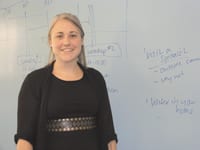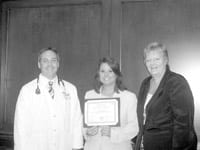What’s the Big Idea? – TechSpring Succeeds in Connecting Technology with Healthcare
Eric Harry says genomics is one of those “sexy” areas of healthcare, and scientists are certainly engaged in exciting work to learn how genes influence disease.
“But we know for a fact,” he went on, “that zip code is a greater determiner of health outcomes than your genes. And we have a lot of high-risk patients at Baystate. There’s a lot of poverty here, a lot of patients at risk because of their zip code.”
Harry, community manager at TechSpring, Baystate Health’s technology innovation center in downtown Springfield, was talking with HCN about a far different discipline than genomics: data analytics. When TechSpring opened two years ago, one of its partners, Dell, went to work in this area, trying to identify which patients are most at risk of becoming “high utilizers” of healthcare — or are, in other words, one major event from becoming very sick.
“What was their medical record like before they got sick, and who has those indicators now?” asked Jill McCormick, manager of the innovation center, adding that such studies are critical to the growing field of population health, which is critical at a time when hospitals must move away from the old, inefficient fee-for-service model into a value-based care model that seeks to keep people out of the hospital altogether.
“Our population will benefit if we make these changes,” she added — and analytics will be an important piece of the puzzle.
TechSpring, which opened two years ago in Springfield’s emerging downtown innovation district, matches private enterprises with partners and expertise from across the Baystate Health system to take on some of healthcare’s most difficult challenges. The goal is to create new technology solutions and products that could be used to improve health outcomes.
TechSpring owes its existence in large part to a $5.5 million grant from the Massachusetts Life Sciences Center, an investment agency charged with implementing then-Gov. Deval Patrick’s 10-year, $1 billion Life Sciences Initiative that supports life-sciences innovation, research, development, and commercialization.
TechSpring offers partners flexible space to work and the ability to collaborate directly with providers from Baystate Health on their projects, assessing the needs to be met in today’s healthcare environment, and testing potential responses to those needs.
“We work closely with Baystate Health to identify problem areas, or where they are investing in problems that need to be fixed,” McCormick said. “For example, where do they see population health going?”
One possibility is working with organizations like Partners for a Healthier Community on how to incorporate data on poverty and housing issues into patients’ health records, so a doctor recognizes that the housing situation is contributing to the person’s health status.
The idea, she added, is to arm providers with the data they need to empower patients to take more control of their own lives. The fact that TechSpring is located in a demographically diverse region is one of its strengths.
“Springfield is geographically interesting, between New York and Boston,” she said. “It has a great mix of rural and urban, and it has interesting economic challenges, that made this the ideal proving ground for technology solutions that represent what the U.S. market looks like, versus your Cadillac medicine or high-tech areas.”
Actually, McCormick added, TechSpring leaders tend to shy away from the word ‘high tech,’ focusing on how technology can solve problems in areas like population health, rather than on what’s new and hot in technology itself.
“It’s really about what is practical and usable and can be applied now in helping the health system succeed,” she explained, “by addressing the needs of the population and helping patients achieve better health outcomes.”
Free Falling
When TechSpring opened in late 2014, it had already lined up a number of partners — companies that were proven and experienced in the industry, including IBM, Premier Inc., Cerner Corp., Dell, Medecision, and Mainline Information Systems. But the goals were still ambiguous.
“It’s a startup,” McCormick said. “It’s a startup within a large health system, so you just have to start trying stuff. What works? What’s scalable? What can you do in that space?
“What does it mean to change the industry?” she went on. “What does it mean to drive positive change? What are you working on, what is Baystate working on, and how do we bring you together to actually do something, and do it in a way that’s designed for learning and proving, rather than sales and acquisition?”
Harry compared the experience to jumping out of a plane for the first time, but McCormick amended the analogy. “Actually,” she said, “we’re building the plane while we’re flying in.”
Whatever the comparison, Harry said, TechSpring was a risky venture because nothing like it had been attempted in the region, and it demanded a total buy-in from Baystate and its partners to succeed.
There have been 22 such partners so far, including a handful of large companies, about five tiny startups, and a dozen or so companies in the middle, size-wise.
For example, a company called Praxify is working to help doctors balance efficiency and patient satisfaction in the era of electronic health records, or EHRs. “Oftentimes, documentation gets in the way of direct patient care,” McCormick said.
Other projects have involved remote patient monitoring — and how to get recorded outcomes into medical records so providers can make care decisions between patient visits — and advanced clinical decision support, or ACDS, which aims to turn medicine into more science than art by establishing, through hard data, the right course of action in various clinical situations.
Originally, potential partners were bringing ideas to Baystate, and the health system was trying to fit their ideas into its framework. That has changed, however, into what Harry called a “marketplace.”
“Now we’re going into Baystate and talking to providers and figuring out where the problems are, really defining those problems, and then we go out and look for innovators, telling them, ‘here are the problems we’ve defined. Can you solve them?’ We’re creating a match-making process. We have a list of problems, well-defined, already sourced, and innovators submit a statement of interest to solve those problems, as opposed to saying, ‘hey, I have this solution. Can I work with you at Baystate?’”
The partners, interestingly, are not being paid for their work; in fact, they pay to access Baystate’s resources and human capital through TechSpring. But if they get to a point where a solution works, they have a direct line to become a successful vendor at Baystate and beyond.
“They’re developing a true solution, solving a real problem, and if they can do that here, they can do it anywhere,” Harry said.
That setup works well for large partners with significant financial resources, but perhaps isn’t as ideal for early-stage startups, so TechSpring is working to develop a model to improve access to companies that can’t afford to pay up front.
Boston-based CarePort Health, one of TechSpring’s initial partners, specializes in helping providers optimize post-acute outcomes and costs by guiding patients across the care continuum and tracking their recovery in real time. “They earned a commercial customer relationship with Baystate and had broad market success from there,” McCormick said, adding that the company was recently purchased by Allscripts, a major EHR vendor.
“When you finish working with TechSpring,” McCormick said, “it should either put you in a position to receive additional funding or propel your solution toward broad market success.”
Happy Employees
Meanwhile, a TechSpring partner called Imprivata works on the security side of healthcare, developing products like a badge that employees swipe at their computers to enter any program they have access to, instead of having to remember passwords for each one. Another current project is a biometric palm-vein reader. Each scan is recorded in a database, and physicians can then swipe anyone entering the ER and immediately pull up their medical records.
“We have a nice pipeline with Imprivata; they’re already popular and well-received in the hospital, and we get to work on what’s next for them,” McCormick ssaid. “They look for intersections between convenience and patient security. When I bring these solutions to the health system, they’re psyched because they know Imprivata is going to make their lives easier.”
Such solutions, however, begin with conversations — between providers and TechSpring partners, and between the tech companies themselves — and that’s another area where the innovation center excels, Harry said. “We’re really driving ecosystem thinking within healthcare.”
To that end, TechSpring also offers co-working, office, and event space in flexible month-to-month memberships for anybody working at the intersection of technology and healthcare. Meanwhile, a monthly networking event called Tap Into TechSpring features networking and content-rich speaker programs, so various stakeholders get a sense of what everyone is working on, and sometimes new collaborations form.
“I’d say a lot of people in the healthcare sector are cynical about this type of thinking. ‘Show me the money’ is their way of thinking,” Harry said. “We’re helping people understand there probably is money, and a way that everyone can benefit, but until we get together, that can’t happen.”
Added McCormick, “it’s not that we’re just dreaming about what the future of healthcare could be. We’re actually executing against what we think the future of healthcare can be.”
At the end of the day, Harry said, TechSpring is about solving health problems — at a time of great shifts in the way care is delivered — and, ultimately, changing lives.
“Can everyone win?” McCormick asked. “We think so. Our bet is they can. And we’re taking all these opportunities to prove that everyone can win — especially patients.”





Comments are closed.